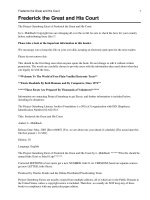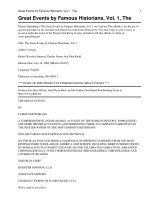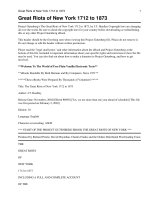The Great Telecom Meltdown Artech House Jan 2005
Bạn đang xem bản rút gọn của tài liệu. Xem và tải ngay bản đầy đủ của tài liệu tại đây (1.3 MB, 213 trang )
The Great Telecom Meltdown
For a listing of recent titles in the Artech House Telecommunications Library, turn to the
back of this book.
The Great Telecom Meltdown
Fred R. Goldstein
artechhouse.com
Library of Congress Cataloging-in-Publication Data
A catalog record for this book is available from the U.S. Library of Congress.
British Library Cataloguing in Publication Data
Goldstein, Fred R.
The great telecom meltdown.—(Artech House telecommunications Library)
1. Telecommunication—History 2. Telecommunciation—Technological innovations—
History 3. Telecommunication—Finance—History
I. Title
384’.09
ISBN 1-58053-939-4
Cover design by Leslie Genser
© 2005 ARTECH HOUSE, INC.
685 Canton Street
Norwood, MA 02062
All rights reserved. Printed and bound in the United States of America. No part of this book
may be reproduced or utilized in any form or by any means, electronic or mechanical, including
photocopying, recording, or by any information storage and retrieval system, without permission
in writing from the publisher.
All terms mentioned in this book that are known to be trademarks or service marks have been
appropriately capitalized. Artech House cannot attest to the accuracy of this information. Use of
a term in this book should not be regarded as affecting the validity of any trademark or service
mark.
International Standard Book Number: 1-58053-939-4
10 9 8 7 6 5 4 3 2 1
Contents
Hybrid Fiber-Coax (HFC) Gave Cable Providers an
Advantage on “Triple Play”
RBOCs Took the Threat Seriously
Hybrid Fiber-Coax Is Developed
8
9
ix
122
123
123
Cable Modems Sparked a Cable ISP Boomlet
Fiber to the Home Kept Moving Further into the
Future
Exuberant Prices for Existing Systems as Industry
Consolidated
124
Overbuilding Was Often a Costly Disaster
Endnotes
129
130
DLECs and ELECs: An Exercise in Oversupply
133
DSL First Failed as a Video Offering
134
The Telecom Act Invites Novel Use of Unbundled
Loops
Collocation Did Not Come Cheap
ILECs Controlled the Mass Market for DSL
134
134
135
Capital Poisoning Led DLECs to Overexpand
Dropping Like Flies
Survivors Face the ILECs’ Regulatory Might
136
138
139
Ethernet LECs Were Data CAPs
Endnotes
140
142
CLECs’ Winning Strategies Are Met by Rule Changes
145
The Telecom Act Anticipated CAPs and Resellers
Total Service Resale Had Little Value or Margin
State Commissions Had to Administer Federal Rules
Unbundled Network Elements Reduced Capital Needs
146
146
147
147
Initial Strategies for Serving “Classical” Voice Business
“Smart Build” and UNE-Loop CLECs
149
149
UNE Platform Displaced Resale and Discouraged
UNE-Loop
150
EELs Created an Opportunity to Serve Businesses
152
The ISP Dial-In Business and CLECs: A Match Made
in Heaven
152
125
127
Contents
xi
Preface
Acknowledgments
1
2
xiii
Ma Bell and Her “Natural Monopoly,” 1876–1969
1
Natural and Unnatural Monopoly
1
Western Union
2
Patent Protection
3
The Kingsbury Commitment
4
The Slow Pace of Progress
5
The Smith Decision and Universal Service
6
The Final Judgment
7
Hushaphone and the First Cracks in the Monopoly
7
The Disruptive Transistor
Endnotes
8
10
The Rebirth of Competition
11
Carterfone Made the Network More Valuable
11
Registration Opened up the Floodgates
Digitization from the Outside In
12
13
v
vi
The Great Telecom Meltdown
3
The Integrated Voice and Data PBX Bubble
Computer II and the Detariffing of Terminal Equipment
15
18
American Bell and the Embedded Base
19
MCI’s Shared Microwave Opened New Doors
Private Line Competition Led to Rate Restructuring
Execunet Gives Birth to Competitive Long Distance
20
20
22
Sharing and Resale Had Profound Implications for the
Future
The ENFIA Agreement Made Subsidies Explicit
MCI’s Growth Fueled by Antitrust
23
24
24
Endnotes
25
Divestiture: Equal Access and Chinese Walls
27
Vertical Integration
27
AT&T Kept Out of the Computer Industry
Legislative and Antitrust Actions Took Shape
28
29
The Money’s in Long Distance, Right?
Long Distance Rate Restructuring Had Been Planned
Before Divestiture
Birth of the Baby Bells
Stopping at the LATA Boundary
Access Charges Milked the Monopoly
Selecting Equal Access Carriers
800-Number Competition
32
32
34
34
36
38
38
The Centrex Revival
39
Digital Switching Becomes the Norm
40
Digitization of the Transmission Network
The First Fiber-Optic Boom
43
43
ISDN Fails to Make a Dent
45
Digital Access Held Hostage to Local Measured Service
Broadband ISDN Led to the ATM Boomlet
49
50
Regulators Made the Deal, but Fiber Did Not Make it
Home
Endnotes
52
53
Contents
4
5
vii
The Internet Boom and the Limits to Growth
57
The ARPAnet Was a Seminal Research Network
Other Packet-Switching Technologies Had Their
Adherents
57
58
OSI, the Big Committee That Couldn’t
TCP/IP Becomes the Standard
The Acceptable Use Policy
62
63
64
Commercialization at Last
Peering and Tiering
65
66
An Industry Structure Develops
67
Internet Traffic Explodes as the Public Joins
Data Traffic Finally Tops Voice
Short-Term Versus Long-Term Trends
WorldCom Set a Suspicious Pace
69
70
71
72
ISP Pricing Creates Permanent Losses
Investors Subsidized Prices
74
76
Dotcoms Create a Demand Bubble
76
Carrier Hotels Created Too Much Room at the Inn
80
The Bubble Bursts in Equipment Manufacturers’ Faces
Surplus Gear Met Demand
Endnotes
81
82
83
The Deuteronomy Networks
85
The Short-Term Bandwidth Crunch Invited More
Suppliers
ISPs Wanted Dark Fiber
86
86
Qwest Follows Sprint’s Lead Along the Rails
87
Kiewit Sells MFS, Creates Level 3
88
Williams Sold Wiltel, Created Another One
90
Metromedia Sold Cellular and Long-Haul, Created
MFN
91
XO Communications Recycles Cellular Profits
92
Undersea, Undersea, Under Beautiful Sea
93
viii
The Great Telecom Meltdown
6
7
How Much Bandwidth Was Available?
A Falling Price Lowers All Carriers’ Ships
94
95
Endnotes
96
Losing by Winning: Wireless License Auctions
97
Original License Lotteries Led to Farcical Resale
99
The Top Cellular Networks Grew to Profitability
100
Networks Go Digital
101
Auctions as a Fair Way to Allocate Scarce Spectrum
102
The PCS Auction Was a Success
103
“3G” Combined the Allure of Both Internet and
Wireless
European PTTs Had Recently Been Privatized
Bubble-Era Timing Led to Spectacular Bids
“2.5 G” Technologies Suffice for Most Users
106
107
107
Many Large Incumbents Were Left with Huge Debt
Endnotes
109
109
Competitive Access Providers, the Costly Way to
Local Competition
111
RBOC Prices to Large Customers Were Out of Line
111
States Supported RBOC Monopolies More Than the
FCC Did
The FCC Preferred a Market-Based Approach
Satellite Bypass Did Not Quite Fly
113
113
114
Teleport Cracks the NYNEX Monopoly
114
Competitors Outrace RBOCs to Provide Local
Fiber-Optic Connections
Overbuilding Each Other in Top Markets
115
116
The Telecom Act Opens Local Service Competition
The Long Distance Business Declined
117
117
CAPs Had Head Start on Both Service and Debt
118
Fixed Wireless as an Alternative to Fiber?
Overexpansion Led to More Bankruptcies
119
121
105
x
The Great Telecom Meltdown
“Virtual NXX” Made Dial-In Available in More Areas
Reciprocal Compensation Led to Large Initial Profits
154
156
ILECs on the Attack
The Grandfather Clause Locked Out New Entrants and
Squeezed the Old
157
158
New Generation Switching Equipment Lowered Capital
Costs
Enter the Softswitch
159
160
The CLEC Boom and Bust Led to Glut of Vendors
160
UNE-P Dominated CLEC Statistical Growth
162
An ILEC-Friendly FCC Throws New Obstructions at
Surviving CLECs
The Triennial Review Order Fiasco
ISPs Face New Survival Threat from Bush Reelection
163
164
165
Role Reversal: States Become Champions of Competition 166
Endnotes
167
10
Focusing on the Bottom Line
169
Asset Valuation is Risky
170
Accounting Was Scandalous
Investors and Entrepreneurs Played Each Other for a
Loss
171
171
WorldCom and the Limits to Mergers
AT&T Acted on Faith in WorldCom’s Numbers
Global Double Crossing
172
173
174
New Services Need to Fit Into a Food Chain
174
Competitive Realities Will Change
Old Dinosaurs Die Hard
The Next Big Thing Usually Is Not
176
176
177
Endnotes
178
List of Acronyms
179
About the Author
187
Index
189
Preface
The economic boom of the late 1990s included huge investments in the telecommunications industry and related sectors. It was followed by a downturn of
unusual severity, which reduced total paper wealth by trillions of dollars, cost
many thousands of jobs, and saw some of the biggest bankruptcies in history.
While there certainly was a general business cycle at work, the downturn in telecom was not just a cyclical correction, itself a healthy event that routinely shakes
out the weakest players. The downturn was unusually severe, impacting many
well-established as well as young companies; the price pressures that resulted
from so many distressed vendors then put an impossible squeeze on the profit
margins of many of their stronger competitors. These conditions led investors to
avoid anything remotely resembling telecom; the resulting capital squeeze further hurt the remaining survivors. This was not just a low point in the business
cycle; it was economic metastasis, an epic failure, a full-bore meltdown.
Analysts, reporters, and other pundits have frequently sought to identify
the cause of the telecom industry crash. So have industry participants themselves, both market participants and their regulators, eager to pin the blame on
someone else. At the top of many commentators’ lists is the Telecommunications Act of 1996, which opened up local telephone service to competition
across the United States. The Act led to the creation of a huge number of new
companies, many of which went public quickly and visibly, and which failed,
equally visibly, not long afterwards. The Act became law just as the boom was
beginning, and in many ways set the direction of the industry, making it an
obvious culprit.
But readers of mystery novels know that the most obvious “perp” is rarely
the one who did it. It is simply wrong to lay the bulk of the blame for the
xi
xii
The Great Telecom Meltdown
meltdown on the shoulders of the Telecom Act. While its opening of greater
competition did have both positive and negative effects on the economy, and its
ambiguities were, in the long run, quite harmful, both the boom that was
already building up at the time of the Act’s passage, and the bust that resulted,
were the result of many factors, most of which were set in motion years earlier.
Among them were the AT&T divestiture of 1984, the development of fiber
optics, the birth of the public Internet, the explosion in wireless telephony, and
the novelty of electronic commerce. And while these factors did lead to irrational economic behavior and, eventually, huge losses, they alone can hardly be
held to blame, either. Rather, they built up to a coincidence of opportunity,
during a time of strong economic growth, that provided fertile ground for investors and entrepreneurs alike who, not fully understanding the dynamics of the
industry, jumped in with too much capital and too little common sense. This
fueled a perfect storm, a confluence of factors that fed on each other, in which
the impact of the whole was far larger than the sum of its parts would otherwise
have been.
The story that will follow begins with the tale of the telecommunications
industry from its birth in the nineteenth century up through its greatest debacles
in the early twenty-first century. It is the tale of an industry whose feisty,
competitive beginnings were almost forgotten as it became a staid, regulated
monopoly through much of the twentieth century. Competition was
reintroduced in stages, piece by piece: Terminal equipment and leased-line
transmission services first became competitive, then long distance telephone
calls, wireless telephony, Internet service, and finally local data and voice
services. It was this piecemeal transition from monopoly to competition, a
necessary change by any rational measure, that eventually led to the meltdown.
The industry’s most experienced leaders were monopolists at heart, some of
whom had trouble adapting to a competitive world. New participants more used
to competitive industries, as well as their investors, underestimated the power of
entrenched monopolies. Regulators provided inconsistent guidance, at times
encouraging massive investment, but often leading to endless litigation and
regulatory uncertainty, eventually helping to create a most unpleasant
investment climate.
Acknowledgments
I could not have produced this book without the assistance of the many people I
have worked with over the years, both co-workers and clients, who have exposed
me to a wealth of information that I hope to be able to share a tiny fraction of
herein. I am especially thankful to my former teammates at the late lamented
Arthur D. Little Inc. and the recently revived BBN Corp., and at gone-but-notforgotten Digital Equipment Corp. I also wish to thank the many people I
worked with on various standards bodies and, more recently, the many experts
whom I have been fortunate to correspond with on the Internet. Credit is also
due to Google, the greatest research tool ever developed, and the many information providers on the Internet. Special thanks also go to my wife, Judy Hyatt,
and my children, Ethan and Amelia, for indulging me during the preparation of
this book.
xiii
1
Ma Bell and Her “Natural Monopoly,”
1876–1969
The telecommunications industry has a deeply ingrained heritage of monopoly.
Not that it always was one, or that it always needed to be one, but for almost a
century, monopoly was far more common than competition. And it was the
heritage of this monopoly that shaped the industry going in to the boom years of
the 1990s. While some competition had begun to take root, it was being introduced sector by sector. Competitive suppliers were dependent on monopolies,
and monopolies, to some extent, depended on competitors. So it may be helpful
to determine how and why the monopoly came about in the first place.
Natural and Unnatural Monopoly
The usual explanation, which the “Bell System” as well as other monopoly telephone companies worldwide used for years, was that telecommunications was a
“natural monopoly.” To the average person, this phrase simply implies that a
monopoly exists as sort of a force of nature, something inevitable like the
weather. You may not like the weather, but you do not argue with Mother
Nature. And you did not argue with Mother Bell. Regulators liked this argument and compounded it with rules and regulations designed to enforce the
monopoly.
But such de jure monopolies are not the same as a true natural monopoly.
Indeed the term natural monopoly has a specific meaning to economists. It is
what happens when a given business has sufficient economy of scale, and a high
enough entry cost, such that a new competitor would necessarily have higher
1
2
The Great Telecom Meltdown
unit costs than an incumbent, and have little chance of succeeding. In such a
case the lowest average cost is theoretically achieved when there is only one
provider [1]. Natural monopolies thus take care of themselves. They do not
need protection; indeed, it is more likely that governmental action be taken to
break them up, in order to let the benefits of competition happen. Or, as happened to the telephone industry, a natural monopoly is subjected to regulation
as a substitute for the competition that would otherwise keep profits in check.
Natural monopolies are not always safe: New technologies can create substitutes
or erode their scope. The telecom boom of the 1990s occurred as the monopoly was eroding;perhaps some of the business failures that resulted were
caused, in part, by underestimating the residual natural monopoly power of the
incumbents.
Western Union
The first commercial form of electrical telecommunications was the Morse telegraph. It was a revolutionary invention that, along with the railroad, reshaped
the United States and Europe during the 1840s. No longer were goods and messages conveyed by horse; the iron horse could now carry people and goods over
long distances, whereas the telegraph could send information over long distances
in minutes.
The telegraph industry in the United States had some early competition,
but a number of companies came together under the control of Western Union.
It held monopoly power, not by regulatory fiat but by a combination of natural
monopoly (economies of scale) and aggressive business tactics. But Western
Union was apparently becoming a bit complacent by the 1870s. Its digital transmission technology was about to be upstaged by another revolutionary invention, analog transmission of voice.
It is still debatable as to whether the telephone was really invented by Alexander Graham Bell or by Elisha Gray. Bell’s original telephone, for which he was
granted the patent in 1876, did not have a separate mouthpiece and earpiece. It
probably did not work well at all. Gray is credited with inventing the microphone; his two-part telephone design was closer to what actually caught on. Legend has it that Western Union turned down a chance to buy Bell’s patent
because the company did not think that the telephone would ever catch on. A
more likely explanation is that it thought his patent was not valid; the company
had instead bet on Gray. Western Union had previously merged its own manufacturing operations into Gray’s company, Gray and Barton, creating the Western Electric Company, and both Gray and Bell had filed patent applications on
the telephone. But Bell had the better patent lawyer; Bell’s company sued Western Union for patent infringement and settled in 1885.
Ma Bell and Her “Natural Monopoly,” 1876–1969
3
Patent Protection
Bell’s patent granted a monopoly on the telephone for 17 years [2]. During that
time, telephone service was introduced into a number of major American cities.
Switchboards were set up and telephone poles erected. The American Bell Telephone Company grew rapidly, but telephone service was simply not available in
areas the company chose not to serve. American Bell adopted a vertically integrated business model: Following its acquisition of Western Electric in 1881, it
was both equipment manufacturer and service provider.
Bell’s original patent expired in 1893, at which point any number of new
players entered the scene. Within the next 10 years, two million non-Bell telephone lines were installed across the country [3], and American Bell’s market
share was down to around 40%. While many of the new telephone companies
served areas that Bell had ignored, others provided head-on competition in Bell
Telephone’s own markets. But Bell continued to collect and use a variety of patents to protect its interests.
One of Bell’s main competitors for the manufacture of telephone gear
was Kellogg Switchboard and Supply. Sometime before 1903, Bell secretly
bought controlling ownership, through a trust, from a relative of the
founder. Kellogg supplied many of the new competitive service providers. Bell
brought a patent infringement suit against Kellogg and its customers, which
Kellogg of course did not vigorously defend. This effort only ended when the
secret ownership was revealed, and a lengthy court battle voided the sale as
anticompetitive.
Another patent was more successful at helping Bell cement its grip
over the industry. Telephone wires have a limited range: A plain copper wire
pair can only carry intelligible voice, between conventional telephones, for a few
miles. Michael Pupin, an immigrant from what is now Serbia who taught at
Columbia University in New York, filed a patent in 1899 covering the use of
loading coils on telephone lines. Noted British physicist Oliver Heavyside
had proposed the idea a few years earlier; both Pupin and a Bell engineer,
George Campbell, filed to patent the technique at nearly the same time. Loading coils (inductors placed in series with the line at fixed intervals) cancelled
the capacitance between the two paired wires on the line, greatly reducing
the voice-frequency attenuation of the line and allowing calls to go for at
least tens of miles. Unlike the more famous Gray-Bell patent dispute of
1876, the patent office ruled in favor of Pupin. Bell purchased the patent from
Pupin for $455,000, giving the company control of the only method then
known for allowing intercity telephone calls. (Amplifiers came later, after the
vacuum tube was invented.) So while local telephone service was, at that time,
competitive, only the Bell Company could provide any sort of long distance
service.
4
The Great Telecom Meltdown
The Kingsbury Commitment
The telephone industry reached a turning point in 1912. Before then, AT&T (a
name adopted in an 1899 corporate reorganization) had refused to interconnect
its network to the thousands of independent telephone companies. Controlled
at that point by famed robber baron J. P. Morgan, AT&T sought instead to
purchase its competitors or otherwise use its strength to monopolize the industry. The U.S. Department of Justice filed suit, and in 1913, AT&T Vice President Nathan Kingsbury agreed to a settlement that became known as the
Kingsbury Commitment. This provided for interconnection between AT&T
and all of the independent telephone companies [4]. AT&T also agreed to stop
buying up independents, except under special circumstances (such as bankruptcy), and it sold the controlling stake in Western Union that it had acquired
in 1909.
Kingsbury marked the beginning of a new industry structure. AT&T was
to remain the undisputed king of long distance and by far the largest of the local
service providers, whereas independent telephone companies were allowed to
carve out their own niche markets. The number of independents that actually
competed with Bell declined, whereas new independents provided service to
ever-more-rural territories. The 1921 Willis-Graham Act explicitly favored a
regulated monopoly structure, allowing competitive local providers to merge.
None of the remaining competitive independents survived the Great Depression. By the time the Communications Act of 1934 was passed, creating the
Federal Communications Commission (FCC), there was no dispute that telecommunications was a regulated monopoly industry. AT&T’s Bell System telephone companies controlled about four-fifth’s of the country’s telephone lines,
whereas several thousand independents provided service to the rest, mostly in
rural areas.
AT&T’s monopoly only grew tighter over the years. Not only did the
regulated telephone companies provide both local service and the sole access to
long distance, but they also had a legal monopoly on “terminal equipment,”
devices such as telephone sets and switchboards that attached to the network. A
narrow exception was carved out for press Wirephoto machines, based on the
First Amendment’s guarantee of freedom of the press. In 1949, as the national
television networks were being developed, the FCC denied the broadcasters permission to own their own microwave relay networks. It essentially turned over
the civilian part of the microwave spectrum to AT&T’s control, forcing ABC,
NBC, and CBS to interconnect their stations via AT&T’s service. That midcentury period was the height of the monopoly’s power. One could not compete
with AT&T, and one could not even self-provision services that AT&T was
willing to offer, or for that matter some services that AT&T might be able to
offer, even if it chose not to.
Ma Bell and Her “Natural Monopoly,” 1876–1969
5
The Slow Pace of Progress
As a protected monopoly, AT&T had little concern about competitors developing new technology. Its own research arm, Bell Labs, was responsible for many
breakthroughs, but many of these seemed to be at cross-purposes with the
parent company’s apparent goal of meting out progress in carefully measured
dosages.
This was apparent, for example, in the development of the dial telephone. During its original 17-year monopoly, telephone service was handled
entirely via manual switchboards. AT&T employed thousands of operators,
who sat in large rooms at boards full of plugs and jacks. While telephones had
numbers, it was possible for an operator, especially in a small town, to place calls
by name.
Almon B. Strowger was an undertaker in Kansas City who became convinced that the Southwestern Bell telephone operators were diverting his calls to
a competitor. In 1888, he set out to address the problem via technology; in
1891, he was granted a patent on the first automatic dial telephone exchange.
Although he sold the rights and did not long remain in the telephone industry,
Strowger’s design caught on among independent telephone companies. The
company founded on his invention, Automatic Electric, supplied dial telephone
exchanges to many of the independent telephone companies. During that early
era of competitive telephone service, many cities had all-manual Bell networks
competing with dial-enabled independents. AT&T itself did not begin to automate its exchanges until the 1920s. Although the Strowger system, sometimes
called Step-by-Step, was a worldwide success (manufacture continued into the
1960s), the first Western Electric dial exchanges used instead a homegrown variant called Panel. Eventually, long after Strowger’s patents were history, Western
Electric adopted the Strowger design as well, deploying “stepper” switches in
many parts of the country.
While progress and innovation are nowadays almost universally lauded as
being for the better, slow innovation had a certain logic of its own in the regulatory environment of the mid-twentieth century. Slow depreciation schedules
could result in lower local service rates. That was the main priority of many
regulators; it was something that the average consumer could understand.
Depreciation has to take into account both the natural failure rate of old
equipment and the economic impact of obsolescence. No one ever accused the
old Western Electric of shoddy manufacturing; its gear was manufactured to
last. Forty-year life spans for electronic equipment such as telephone switches
seem almost absurd in today’s fast-paced world, but they were the norm for decades. For many years, AT&T did not even selectively depreciate its capital plant
based on actual life span; instead, all capital expenditures for a given year were
lumped into a “vintage group” and depreciated at one rate. Thus telephone
6
The Great Telecom Meltdown
poles, switches, and cars were all depreciated together, generally at rates set
by state regulators. (A second set of books was needed for tax purposes, since
state regulators and the Internal Revenue Service had different depreciation
schedules.)
The Smith Decision and Universal Service
One of the policy goals of the FCC’s early years was to promote universal service,
making the telephone a standard part of every American home. This had both
public and private benefits. The public, of course, benefited from policies that
made telephones affordable. This was, to some extent, used to justify the
monopoly: Monopoly profits (i.e., prices in excess of what they would be in a
competitive market) could be used to subsidize the price of service for those who
otherwise might not be able to afford it.
This largesse was divided between two broad classes of recipients. Rural
telephone service is far costlier to provision than urban; since most of the cost of
service is in outside wire, the low density of rural areas leads to very high capital
expenditure requirements. Residential subscribers in general also got a break:
Business line rates were kept much higher than residence line rates, so that the
former could subsidize the latter.
The mechanisms of the subsidy were anything but transparent. Besides the
disparate rates for residential and business lines, AT&T charged far in excess of
marginal cost for long distance service. AT&T’s Long Lines Division then
shared the take with the local telephone companies via the separations and settlements process. While the rules for this were arcane, they generally involved
dividing the fixed cost of local service between interstate and intrastate jurisdictions. The interstate portion was covered via long distance settlements. The
local companies’ share of the long distance bill was calculated based on both the
proportion of line usage that was interstate and the company’s relative investment: A local telephone company with higher average costs, like most of the
independents, would thus get a higher percentage of the toll—it could even
exceed 100%. Urban Bell System subscribers were, in effect, paying part of rural
subscribers’ bills.
This system dated back to a pivotal decision by the U.S. Supreme Court in
1930, Smith v. Illinois Bell. That ruling held that local telephone lines were, in
part, subject to federal jurisdiction because they carried a mix of interstate and
intrastate traffic. The net result was to move some of the cost of local service
onto the monthly toll bill. This decision has remained the law of the land. The
FCC eventually decided to recover much of this fixed cost on a fixed basis,
rather than from usage charges, thus resulting in the “FCC line charge” on modern phone bills.
Ma Bell and Her “Natural Monopoly,” 1876–1969
7
Less widely discussed is the private benefit that AT&T received from the
policy of universal service. The value of a network is in large part a function of
the number of users [5]. If the telephone were a luxury, then certain tasks would
have to be left to other media, such as letter post. Universal service, among other
things, allowed businesses to count on their customers’ having a telephone, thus
making business lines more valuable. By enthusiastically embracing universal
service as a policy goal, AT&T both protected its monopoly and grew its business. Regulation of its prices was an acceptable trade-off.
The Final Judgment
While the mid-century FCC was an unabashed fan of monopoly, not everyone
in Washington agreed. The Department of Justice filed an antitrust suit against
AT&T in 1949, demanding that the company sell Western Electric. This would
at least create some competition in equipment manufacturing, which was clearly
not a natural monopoly. Western Electric had until that point been involved in
numerous other lines of business, such as audio equipment, broadcast radio
transmitters, and hearing aids, but it was also in most cases the sole supplier of
many types of equipment to the Bell System companies.
The case was tentatively settled in 1956 in a decision known as the
Final Judgment [6]. AT&T was allowed to keep Western Electric, but the latter’s operations were restricted to those needed to support the telephone company and the federal government. The independent telephone companies thus
had to purchase their equipment from a variety of smaller companies. A few
states did at various later times require their Bell Operating Companies (BOCs)
to purchase some of their equipment from competitors, but that was not the
norm.
Hushaphone and the First Cracks in the Monopoly
A modicum of competition survived the mid-century. Western Union, while no
longer the powerhouse it once was, still maintained its own telegraph service. By
that time, the Morse telegraph had long been replaced by the electromechanical
teleprinter. In 1939, Western Union finally cemented its monopoly on domestic telegraphy by acquiring Postal Telegraph from ITT Corp., while divesting its
international operations (an odd island of competition). A dial-up teleprinter
network, Telex, was developing worldwide; Western Union joined in. AT&T
had a competing service, TWX, built out of the emerging long distance dial telephone network. (Direct distance dialing was introduced to the public in 1951
and rolled out to most telephone subscribers within the next decade.) The two
8
The Great Telecom Meltdown
networks competed until 1981, when Western Union acquired TWX from
AT&T. (A bankrupt Western Union sold both to AT&T in 1990.)
AT&T’s view of its voice telephone monopoly, which was generally
backed up by the FCC and state utility regulators alike, would have been
humorous were it not tragic. The mere concept of “foreign attachment” was
interpreted so broadly that even plastic telephone book covers were technically
forbidden. Passive attachments such as headset shoulder rests, while not uncommon, were technically in violation of the rules. And thus the FCC ruled for
AT&T against allowing the attachment of the Hushaphone—a plastic and
metal cup that slipped over the mouthpiece to keep out background noise—to a
telephone. But in 1956, the makers of the Hushaphone secured a court ruling
that permitted their device to be attached. The basis of the decision was that the
Hushaphone was “privately beneficial” without being “publicly detrimental.”
That was to become the new standard.
The next major opening occurred in 1959, when the FCC’s Above 890
Megacycles decision reversed the course it had adopted a decade earlier and
broadly authorized the construction of private microwave radio systems. A company with sufficient need for bandwidth could now self-provision it for its own
use. AT&T then engaged in a competitive response, something that it had not
regularly had to do for decades. It introduced a new tariff called TELPAK, by
which large numbers of private line circuits within a single company’s network
could be priced as if they were built along a dedicated microwave route. (The
circuits themselves were installed as before; the TELPAK customer, however,
could create a fictitious route map of high-bandwidth pipes, from 12 to 240
voice-equivalent channels apiece, among it sites. TELPAK pricing was based on
the resulting imaginary pipe mileage and the number of channel terminations
along the way.) TELPAK successfully discouraged some actual competition, but
it was withdrawn in the 1970s when the FCC overturned the general prohibition on sharing and reselling circuits that kept TELPAK’s fictitious pipes from
being, on average, particularly full.
The Disruptive Transistor
Other than a few private microwave systems, the 1960s saw little pressure on the
monopoly. But all was not well: Technological progress was creating new
demands on the network, as well as new sources of supply for potential competitors. Key to this was a Bell Labs invention—the transistor—that was worth far
less to AT&T than to the rest of the world.
We do not think much about the humble transistor nowadays. We tend to
think instead about products that contain thousands or millions of them, for
example, very large scale integration (VLSI) chips such as microprocessors and
Ma Bell and Her “Natural Monopoly,” 1876–1969
9
memories. But these complex semiconductors trace their origins back to 1947’s
epic discovery that a small current properly applied to a semiconductor crystal
can cause a large change in the current passing through it. The original transistors were used as substitutes for the then-ubiquitous vacuum tube, first in sizesensitive applications such as hearing aids, and later, as the price fell, in consumer products such as hand-held radios. (In consumer parlance of the 1960s,
the word “transistor” was often used to refer to a transistor radio, typically a
hand-held low-fidelity AM model.) But it was in the fledgling computer industry that transistors arguably had their biggest impact. Even a simple digital computer of the early 1950s needed thousands of vacuum tubes, each consuming
several watts of electricity to run its filaments, thus using huge amounts of
power and generating vast amounts of heat in the process. The market for
room-sized tube computers was small. Transistors enabled computers to be
smaller, faster, cooler, and cheaper. While few businesses owned a computer in
1955, they were commonplace by 1965.
Even in those early days, it was clear that computers needed to communicate: For one thing, users generally sat at terminals some distance from the “glass
houses” where the computers were kept. (Actual computer networking as we
know it today had yet to develop.) This was, on the one hand, an opportunity
for the Bell System to increase its business; even in the early 1960s, forecasts had
data traffic levels eventually eclipsing voice. But it was terribly disruptive as well.
Computer technology changed far too rapidly for Bell’s slow depreciation
schedules, let alone its glacial rate at which it introduced new services. Computers and semiconductors thus threatened the monopoly business model both
from outside the network, where they led to demand that could not be easily
sated, and from inside, where faster-moving technology threatened to make
obsolete billions of dollars of undepreciated electromechanical and tube-based
equipment.
Federal policy finally began to catch up with technology in the late 1960s,
when the FCC made two epic decisions that permanently changed the scene.
The Carterfone decision ended the telephone company monopoly on terminal
equipment; it led to the competitive availability of a wide range of devices,
including modems, answering machines, PBX systems, and cordless phones.
The MCI decision started the demonopolization of long distance service. While
narrowly tailored, it released a freight train that could not be derailed, leading,
eventually, to the inevitable breakup of the Bell System.
The pattern of monopoly that took hold in the United States was matched
around the world. Many countries viewed the telephone network as a natural
function of their existing postal monopolies. Others eventually nationalized privately owned telephone companies. As the monopoly was being dismantled in
the United States, other countries followed, often very slowly and cautiously.
First their monopolies were privatized; competition was then slowly introduced.









